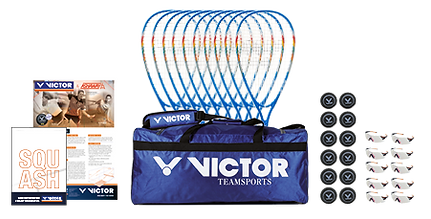Squash
The rebounding sport of squash is played in singles or doubles on the squash court. There are special squash balls, which are available in different speeds, so that also beginners will quickly enjoy the game. The equipment also includes a squash racket. The aim of the game is to hit the ball in a way that the opponent cannot reach it before it touches the ground for the second time. In squash, the opponents share the playing field. The side walls are included in the game.
Squash is played in a limited space (9.75 m x 6.40 m), the squash court. On the walls and on the floor are markings that define the playing field and the serving area. On the front wall is a board or sheet of metal called Tin. If a ball lands there, it is out of the game. Tournaments are often played in complete glass courts. A white ball is played on these courts.
The Squash Ball
The squash ball is made out of rubber and has a diameter of approximately 4 cm. The hollow ball contains a drop of liquid gas, which creates an overpressure when heated. The ball must be played warm at the beginning to reach its full bounce.
For professionals, squash balls reach speeds of up to 200 km/h. For this reason, the wearing of safety goggles is mandatory in some official competitions.

Squash Rules
Squash Rules
THE BALL
In squash, there are four play balls, which differ in their bouncing behaviour and are marked by a coloured dot. A ball with a blue dot bounces very strongly and is therefore easier to play back against the wall. A ball with a double yellow dot is harder to reach because it hardly jumps at all.
blue - fast (for beginners)
red - medium (for beginners)
yellow - slow (for advanced players)
double yellow - very slow (tournament ball)
COURT
The playing field is marked by the upper coloured line, where the lines belong to the game aphid. The off also includes the board (also called "Tin").
BREAKS
The game is played without interruption in each set. There should be no delay between the end of the ball change and the serve. A break of maximum 90 seconds is possible between sets. The pitch can be left to change defective clothing or equipment.

COUNT TILL 11 - POINT A RALLY
In squash, a player wins a set by first reaching 11 points. However, if the score is 10:10, the player who first reaches 2 points wins (e.g. 13:11, 19:17, 104:102, etc.). The game is played for three winning sets. Every point counts.
GAME RULES BEFORE THE GAME
The right to serve is determined among the players by turning a club (similar to throwing a coin). The serving player can choose the field to serve, after which the field is changed after each point until a change of serve is achieved. Here the new serve player may choose again.
WINNING POINTS
A rally is won when the ball bounces twice on the pitch after a valid serve or when the opponent plays the ball out of bounds or against the board / "tin".
SURVEY
At least one foot must be completely in the service area when hitting the ball. The ball must be played with the bat when it is served and hit from the air. The ball can be thrown high or dropped.
The serve is not valid if the ball has touched the wall or the floor before the first racket contact. After the ball has been played, it must touch the front wall between the serve and the upper outline. After contact with the wall, the ball has to land in the opponent's area and may touch the walls (bordering his area).
The person receiving the ball is allowed to play the ball in the air as soon as it has made contact with the front wall (volley shot). If one of these conditions is violated, the serve is invalid.
LETBALL / POINT RULES
If there is an (unintentional) blocking in the game, one can and should demand "Let". The so-called "let rule" comes into force if a blocking of the opponent occurs on the way to the ball or if the opponent could be hit indirectly (e.g. side wall - opponent) when hitting the ball. The rally is then repeated.
The so-called "point or stroker rule" comes into force when
-
a blocking of the striking or swinging movement takes place
-
the opponent could be hit directly by the ball when hitting
-
a deliberate blocking takes place
Basically, you should always try to give the ball "free" after your own drive.
OFFER FOR SCHOOLS



